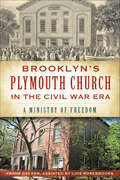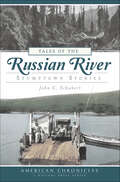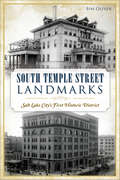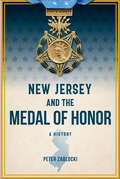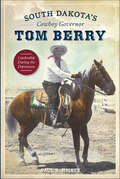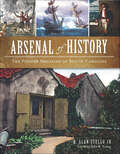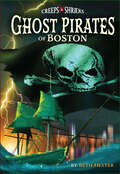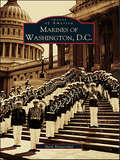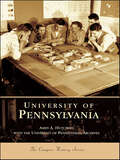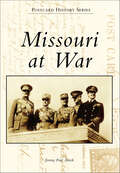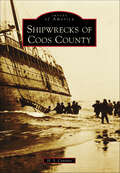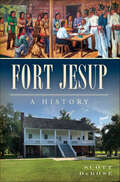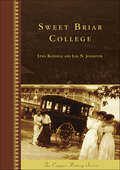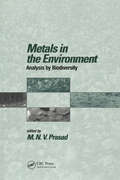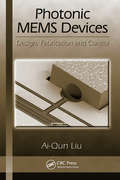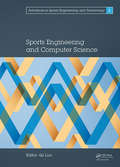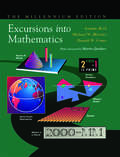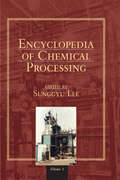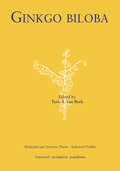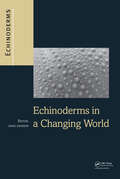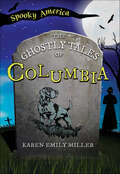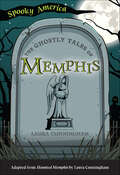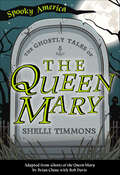- Table View
- List View
Brooklyn's Plymouth Church in the Civil War Era: A Ministry of Freedom (Civil War Series)
by Frank DeckerAs the financial capital of the nation, Manhattan had close ties and strong sympathies with the South. But across the East River in Brooklyn stood a bastion of antislavery sentiment--Plymouth Church--led by Henry Ward Beecher. He guided his congregants in a crusade against the institution. They held mock slave auctions, raised money to purchase freedom for slaves and sent guns--nicknamed "Beecher's Bibles"--to those struggling for a free Kansas. Harriet Beecher Stowe, Beecher's sister, wrote the influential "Uncle Tom's Cabin," and Lewis Tappan and George Whipple led an enormous effort to educate freed slaves. Plymouth Church was not only publicly important in the fight for abolition but also a busy Underground Railroad station. Once the Civil War broke out, the congregation helped raise troops and supplies for the U.S. Army. Discover this beautiful church's vital role in the nation's greatest struggle.
Tales of the Russian River: Stumptown Stories (American Chronicles)
by John C. SchubertThe Russian River has drawn tourists to its colossal redwoods, picturesque seashore and idyllic resorts for more than a century. This collection of John C. Schubert's "Stumptown Stories" columns relates the history of this California river valley through in-depth research and firsthand stories. Ride the first train to chug across the Hacienda Bridge and wave farewell to the town's last train in 1935. Swing around in the many dance halls to the big bands of the 1930s, '40s and '50s. Let the entertaining stories behind once stately, now hidden, landmarks carry you into Stumptown's past. Reconnect over coffee at Pat's Cafe and discover the rich history that formed the Russian River's communities.
South Temple Street Landmarks: Salt Lake City’s First Historic District (Landmarks)
by Bim OliverFrom the earliest days of settlement, South Temple was Salt Lake's most prestigious street. In 1857, William Staines built the Devereaux House, Salt Lake's first of many mansions. The once-bustling Union Pacific Depot eventually found itself increasingly isolated. Downtown's "gleaming copper landmark" overcame numerous hurdles before its construction was finally finished, and the Steiner American Building helped usher in acceptance of Modernist architecture. Evolving to reflect its continued prominence, in 1975, the thoroughfare's core became the city's first local historic district, and in 1982, it made the National Register of Historic Places. Author and historian Bim Oliver celebrates the changing landmarks along these famous eighteen blocks.
New Jersey and the Medal of Honor: A History (Military)
by Peter ZablockiAwarded by the President of the United States in the name of Congress, the Medal of Honor commemorates those who have shaped our nation's history and continue to inspire its future with their acts of valor, humanity, patriotism, and sacrifice. New Jersey has been credited with ninety-three honors in the state's military history. Robert Augustus Sweeney was the recipient of two non-combatant medals when he jumped into stormy waters to save a fellow sailor twice becoming one of only nineteen double Medal of Honor recipients of all time and the only African American to do so. On the infamous day of December 7, 1941, Peter Tomich, serving on the USS Utah, sprung to action when it became evident his ship would capsize from the two Japanese torpedoes, staying behind to man the fireroom to ensure the boilers were secured to prevent an internal fire and saving countless additional deaths.Author Peter Zablocki reveals the harrowing stories of New Jersey's most valorous moments in the defense of our nation and freedom around the world.
South Dakota’s Cowboy Governor Tom Berry: Leadership During the Depression
by Paul S. HigbeeAs South Dakotans endured the Great Depression and developing Dust Bowl in 1932, they elected a cowboy as their governor. Tom Berry rode in the great, iconic 1902 cattle roundup ordered by President Theodore Roosevelt. He established the successful Double X ranch next to the Badlands. Big voiced and tireless, Berry commanded the attention of all, including President Franklin Roosevelt, who broke protocol and called him "Tom" or "Cowboy" in White House meetings. Berry faced bitter political rivalries and weather that threatened to blow South Dakotans off their land, but he is remembered for his humorous wit throughout. Author Paul S. Higbee traces the history of South Dakota and its iconic governor.
Arsenal of History: The Powder Magazine of South Carolina (Military)
by R. Alan Stello Jr.The Powder Magazine was completed circa 1713 as an arsenal to safely store munitions in the South Carolina colonial capital of Charles Town, serving continuously in defense through the 1740s and periodically until the 1820s. Rescued from destruction in 1902, the building has served as a museum for more than a century, inspiring countless other historic conservation efforts. Museum Director Alan Stello presents the story of the state's oldest public building by establishing connections between the arsenal and the significant episodes it has witnessed. Readers will enjoy an introductory look at South Carolina colonial military history while gaining an appreciation for this icon of history and preservation.
Ghost Pirates of Boston (Creeps & Shrieks)
by Beth HesterIT'S A CRUEL SUMM ER Arrrr! All Sam wants this summer is to watch baseball, play video games, and read his favorite supernatural series. Too bad his cousin, Alex, is visiting from San Francisco, and now Sam's stuck playing tour guide to a kid he hardly knows... a kid who'd choose sailing camp over stealing bases any day. Then Sam and Alex find themselves swept up in an epic pirate adventure through the historic streets of Boston. With the help of a three-hundred-year-old ghost-pirate, they'll have to piece together the clues of a long-lost treasure map-- and master a tricky sailor's knot--or risk becoming ghosts themselves! The cousins may not have much in common, but along the way they'll learn that some bonds, like some knots, are truly unbreakable .
Marines of Washington D.C. (Images of America)
by Mark BlumenthalMarines of Washington, D.C. takes the reader on a visual tour that explores the dynamic history of the United States Marine Corps in the nation's capital. The Marines have played an integral role in the development of the social, structural, and political landscape of Washington for over 200 years. This volume traces the history of the Marines from the founding of the "Oldest Post of the Corps," Marine Barracks Washington in 1801, to participation in the War of 1812, the Civil War, the World Wars, and into the modern day. Explore the lasting impact of famous Marines, including Commandant Archibald Henderson, Marine Band Director John Phillip Sousa, and Commandants Alfred M. Grey and John A. Lejeune. Marines of Washington, D.C. highlights the unique relationship between the Marines of the nation's capital, the President, and the citizens of the United States they serve.
University of Pennsylvania
by University of Pennsylvania ArchivesBy the time photography was invented in the 1830s, the University of Pennsylvania, America's first university, was nearly a century old. University of Pennsylvania, a unique photographic collection, focuses on the school's history at its present campus in West Philadelphia beginning shortly after the end of the Civil War and provides images of more than a century of student life inside and outside the classroom. In every category, from campus landmarks to the student body to the traditions that bind the community together, these photographs demonstrate the close connections between Penn's present and its past. They also reveal historical aspects of the Penn experience that have since vanished.
Missouri at War (Postcard History Series)
by Jeremy Paul AmickThe Show-Me State possesses an enduring military heritage that unfolded several decades before it became a state in 1821 and stretches forth to the present day. Missouri has molded many notable military leaders, such as Gen. John J. Pershing, the commander of the American Expeditionary Forces in World War I. It has been the site of a Spanish fort, built in the area that is now downtown St. Louis, and serves as the home of the Liberty Memorial in Kansas City. These people and memorials continue to generate reminders to its citizens of the sacrifices made by the brave men and women who have fought on behalf of the state and nation.
Shipwrecks of Coos County (Images of America)
by H.S. ContinoEuropean settlement of Coos County began with a shipwreck. The Captain Lincoln wrecked on the north spit of the Coos Bay in January 1852. The crewmen built a temporary camp out of the ship�s sails and named it �Camp Cast-Away.� This was the first white settlement in the area. The men eventually traveled overland to Port Orford, where they told other settlers about the Coos Bay and its many natural resources. By December 1853, Coos County was established by the territorial legislature, and several towns were founded; the history of the area had been completely altered by a single shipwreck.
Fort Jesup: A History (Landmarks)
by Scott DeBoseVisit a Louisiana landmark that tells a big piece of the American story.Fort Jesup was founded two centuries ago, a bulwark on the youthful nation's western frontier. During its long run as a military post, it was visited by over one thousand soldiers and officers, many of whom would make a lasting impact on American history. The long list of luminaries includes Presidents Zachary Taylor and Ulysses S. Grant, over forty officers who would become Civil War generals, and two Surgeons General, one of whom would treat Abraham Lincoln after he was shot. Thousands of settlers also passed through on their way to Texas, using the fort as a waypoint on their journey. As citadel and stopping post, Fort Jesup played a critical role during the nation's formative years. Author Scott DeBose shares the sprawling story of this Louisiana icon.
Sweet Briar College (Campus History)
by Lynn Rainville Lisa N. JohnstonOn October 29, 1900, Indiana Fletcher Williams died, leaving her 8,000-acre plantation estate and almost $1 million to create the Sweet Briar Institute.Later renamed Sweet Briar College, it was founded by Williams to honor her daughter, Maria Georgiana "Daisy" Williams, who died tragically in 1884 at age 16. For over a century, Sweet Briar has recruited dedicated faculty and staff to teach exceptional students. The school's award-winning lands include old-growth forests, rare arboreal and floral species, scenic hiking and riding trails, and two lakes. Complementing these natural resources are beautiful campus buildings, many of which are listed in national and state historic registers. Each of these features is rare for a college campus; taken together, they compose the rich physical and community heritage of a historic college that celebrates its 115th birthday in 2016
Metals in the Environment: Analysis by Biodiversity (Books in Soils, Plants, and the Environment)
by M.N.V. PrasadA summary of data on heavy metal accumulation, biomonitoring, toxicity and tolerance, metal contamination and pollution in the environment, and the importance of biodiversity for environmental monitoring and cleanup of metal-contaminated and polluted ecosystems. It advocates the use of bacteria, mycorrhizae, freshwater algae, salt marshes, bryo- an
Photonic MEMS Devices: Design, Fabrication and Control
by Ai-Qun LiuPhotonic MEMS devices represent the next major breakthrough in the silicon revolution. While many quality resources exist on the optic and photonic aspect of device physics, today’s researchers are in need of a reference that goes beyond to include all aspects of engineering innovation.An extension on traditional design and analysis, Photonic MEMS Devices: Design, Fabrication, and Control describes a broad range of optical and photonic devices, from MEMS optical switches and bandgap crystal switches to optical variable attenuators (VOA) and injection locked tunable lasers. It deals rigorously with all these technologies at a fundamental level, systematically introducing critical nomenclature. Each chapter also provides analysis techniques, equations, and experimental results. The book focuses not only on traditional design analysis, but also provides extensive background on realistic simulation and fabrication processes. With a clear attention to experimental relevance, this book provides the fundamental knowledge needed to take the next-step in integrating photonic MEMS devices into commercial products and technology.
Sports Engineering and Computer Science: Proceedings of the International Conference on Sport Science and Computer Science (SSCS 2014), Singapore, 16-17 September 2014 (Advances in Sports Engineering and Technology)
by Qi LuoSports Engineering and Computer Science contains papers presented at the 2014 International Conference on Sport Science and Computer Science (SSCS 2014), held September 16-17, 2014 in Singapore and at the 2014 International Conference on Biomechanics and Sports Engineering (BSE 2014), held October 24-25, 2014, in Riga, Latvia. The contributions hav
Excursions into Mathematics: The Millennium Edition
by Anatole Beck Michael N. Bleicher Donald W. CroweSince it was first published three decades ago, Excursions Into Mathematics has been one of the most popular mathematical books written for a general audience. Taking the reader for short "excursions" into several specific disciplines of mathematics, it makes mathematical concepts accessible to a wide audience. The Millennium Edition is updated with current research and new solutions to outstanding problems that have been discovered since the last edition was printed, such as the solution to the well-known "four-color problem." Excursions Into Mathematics: The Millennium Edition is an exciting revision of the original, much-loved classic. Everyone with an interest in mathematics should read this book.
Encyclopedia of Chemical Processing (Online)
by Sunggyu LeeThis second edition Encyclopedia supplies nearly 350 gold standard articles on the methods, practices, products, and standards influencing the chemical industries. It offers expertly written articles on technologies at the forefront of the field to maximize and enhance the research and production phases of current and emerging chemical manufacturing practices and techniques. This collecting of information is of vital interest to chemical, polymer, electrical, mechanical, and civil engineers, as well as chemists and chemical researchers.A complete reconceptualization of the classic reference series the Encyclopedia of Chemical Processing and Design, whose first volume published in 1976, this resource offers extensive A-Z treatment of the subject in five simultaneously published volumes, with comprehensive indexing of all five volumes in the back matter of each tome. It includes material on the design of key unit operations involved with chemical processes; the design, unit operation, and integration of reactors and separation systems; process system peripherals such as pumps, valves, and controllers; analytical techniques and equipment; and pilot plant design and scale-up criteria.This reference contains well-researched sections on automation, equipment, design and simulation, reliability and maintenance, separations technologies, and energy and environmental issues. Authoritative contributions cover chemical processing equipment, engineered systems, and laboratory apparatus currently utilized in the field. It also presents expert overviews on key engineering science topics in property predictions, measurements and analysis, novel materials and devices, and emerging chemical fields.ALSO AVAILABLE ONLINE This Taylor & Francis encyclopedia is also available through online subscription, offering a variety of extra benefits for both researchers, students, and librarians, including: Citation tracking and alerts Active reference linking Saved searches and marked lists HTML and PDF format options Contact Taylor and Francis for more information or to inquire about subscription options and print/online combination packages.US: (Tel) 1.888.318.2367; (E-mail) e-reference@taylorandfrancis.comInternational: (Tel) +44 (0) 20 7017 6062; (E-mail) online.sales@tandf.co.uk
Chromatographic Detectors: Design: Function, and Operation (Chromatographic Science Series)
by Raymond P.W. Scott"Comprehensively covers the design, construction, and operation of gas chromatography, liquid chromatography, and thin-layer chromatography detectors--all in one convenient, up-to-date source. Emphasizes the essential use of common specifications to describe all detectors, allowing easy comparison of their attributes."
Handbook of Zeolite Science and Technology
by Scott M. Auerbach Kathleen A. Carrado Prabir K. DuttaThe Handbook of Zeolite Science and Technology offers effective analyses ofsalient cases selected expressly for their relevance to current and prospective research. Presenting the principal theoretical and experimental underpinnings of zeolites, this international effort is at once complete and forward-looking, combining fundamental
Ginkgo Biloba (Medicinal and Aromatic Plants - Industrial Profiles)
by Teris A. van BeekA present and up-to-date overview of this particular genus, the contents of this volume include a history of its use, biotechnology, extraction of ginkgo leaves and extensive coverage of the ginkolides; their discovery, biosynthesis, chemical analysis, clinical use and pharmacological activity. Other important constituents are also given attention.
Echinoderms in a Changing World: Proceedings of the 13th International Echinoderm Conference, January 5-9 2009, University of Tasmania, Hobart Tasmania, Australia
by Craig JohnsonEchinoderms are an ancient and diverse group of marine animals with a rich fossil record. They occur abundantly in all modern oceans and at all depths, where they contribute importantly to patterns in biodiversity and to the structure and functioning of marine systems. It is therefore vital to understand how they will respond to a rapidly cha
The Ghostly Tales of Columbia (Spooky America)
by Karen MillerGhost stories from America's heartland have never been so creepy, fun, and full of mystery! Welcome to the spooky streets of Columbia, Missouri! Stay alert! Ghosts lurk around every corner. Even the most unexpected places might be haunted by wandering phantoms. Did you know ghostly soldiers reenact Civil War battles along one road in Woodlandville? Or that a demon pack of hunting dogs can still be heard baying on a haunted farm outside Columbia? Can you believe that in the home of the University president, a former resident decided never to leave? Pulled right from history, these ghostly tales will change the way you see Columbia and have you sleeping with the light on!
The Ghostly Tales of Memphis (Spooky America)
by Laura CunninghamGhost stories from the Birthplace of Rock 'n Roll have never been so creepy, fun, and full of mystery! The haunted history of Memphis comes to life--even when the main players are dead. Come for the blues and barbecue, but stay for the ghosts. Have you heard about the spirits at the Memphis Zoo? Or how about the grisly history surrounding the Grand Carousel? Dive into this spooky chapter book for suspenseful tales of bumps in the night, paranormal investigations, and the unexplained; just be sure to keep the light on.
The Ghostly Tales of the Queen Mary (Spooky America)
by Shelli TimmonsGhost stories from the Grey Ghost herself have never been so creepy, fun, and full of mystery!The RMS Queen Mary's famous haunted history comes to life--even when the main players are dead. Meet Little Jackie, the ship's most playful ghost, see Winston Churchill, who hangs out at the restaurant, and explore the spectral vortex in the first-class pool. Dive into this spooky chapter book for suspenseful tales of bumps in the night, paranormal investigations, and the unexplained; just be sure to keep the light on.
